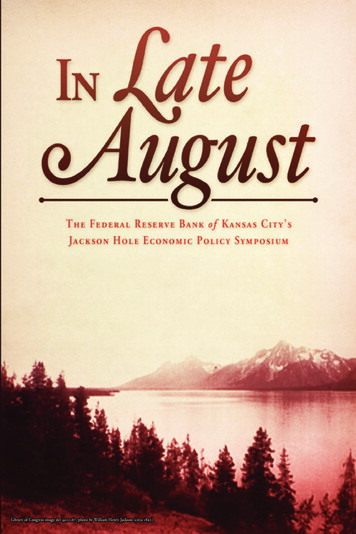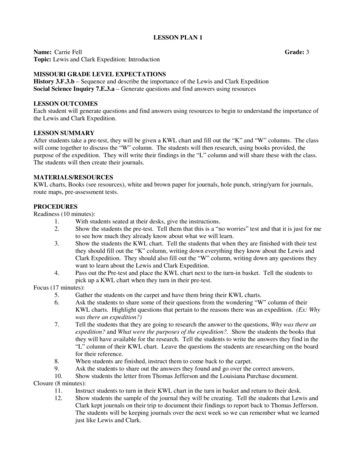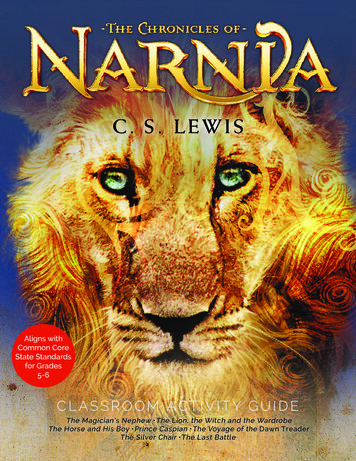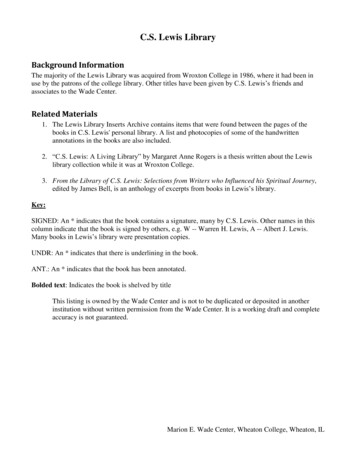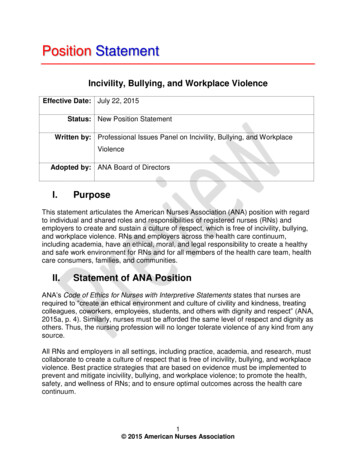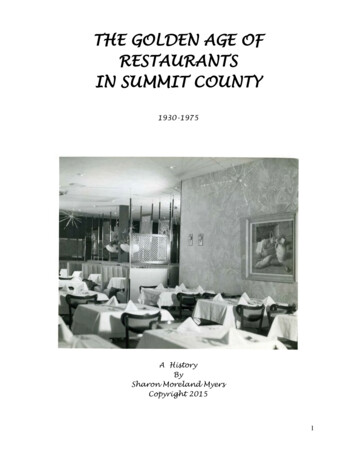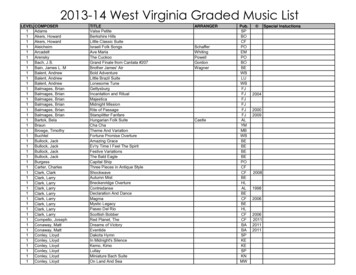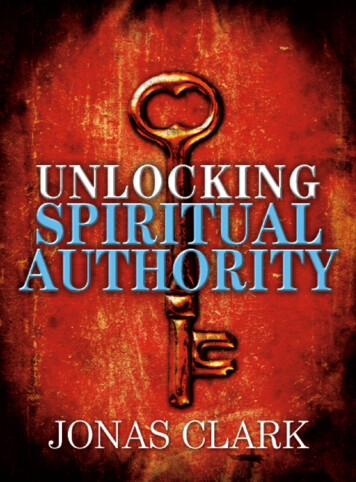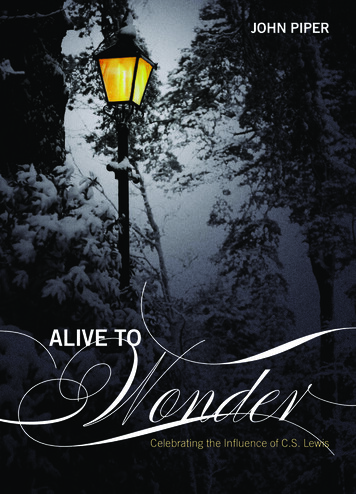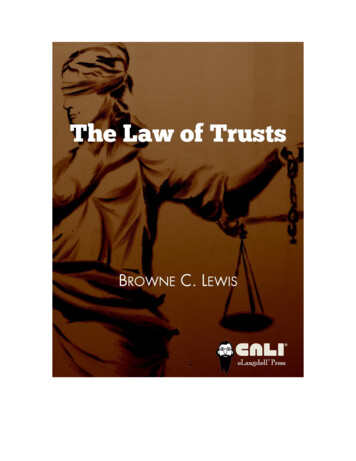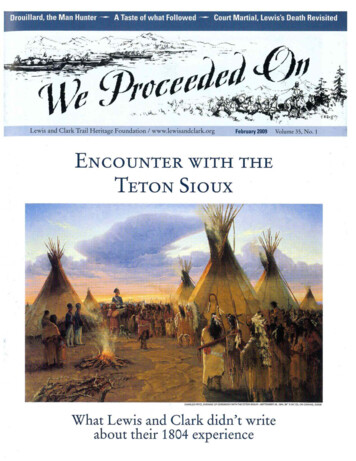
Transcription
Drouillard, the Man Hunter ;A Taste of what Followed -Court Martial, Lewis's Death Revisited- ·.Lewis and Clark Trail Heritage Foundation I www.lewisandclark.orgFebruary 2009Volume 35, No. 1ENCOUNTER WITH THETETONSrouxCHAf1LES FRITZ, EVENING OF CEREMONYvvmlTHErrTON SIOUX- SEPTEMBER 26, 1804, 36 XWhat Lewis and Clark didn't writeabout their 1804 experience54 OIL ON CANVAS, 0 2008
ContentsPresident's Message: Membership and W P O: Have you shared either?2Letters: Runners race along path of Colter's famous route; Genealogyresource wanted for library4Reading Between the Lines6A look at what Lewis and Clark did not write about their encounterw ith the Teton Sioux may offer more information than their journalsBy Brad TennantThe Man HunterTeton Sioux Horseraces, p. 812George D rouillard, best known for his interpretive and hunting skills,was called upon regularly to track and return desertersBy John C.JacksonA Taste of what Followed20Early Euro-American influence on food and wine in the Northwestbrought dining from bland boudin blanc to 15-course extravaganzasin a short period of timeBy Peggy LutzReviews24The Natural World of Lewis and Clark; Mystery of the Bones;Why Sacagawea Deserves the Day Off; and Colter's RunSoundings28Rope Walk Camp, p. 16John New man court martial revisted; What con spiracy? Anotherlook at the evidence involving Lewis's d eathL&C Roundup32Lewis and Clark educator honoredO n the coverPerhaps the moments of highest drama during the entire Lewis and Clark Expeditionoccurred in the last days of September 1804. Tensions ebbed and flowed over the courseof four days spent with the Teton Sioux. At one critical point on September 25, hostilities nearly broke out at the river's edge. At other times, as on the evening of September 26,ceremony and cordiality prevailed as the captains and chiefs attempted to negotiate andunderstand one another inside a huge council lodge. The captains' minimal understanding oftribal dynamics on the northern p lains caused them to inadvertently promote trade proposals that were threatening to the Teton Sioux. The Tetons were the most powerful tribe in th eregion and were able to control the flow of trade goods for their benefit. Confronted nowwith Captain Lewis's proposal of peaceful trading with all tribes, the Teton Sioux felt theirdominant pos.ition was in jeopardy.Saccocommis, p. 21
President'sMessageFebruary 2009 Volume 35, Number 1We Proceeded On is the official publicationof the Lewis and C lar k Trail HeritageFoundation, Inc. Its i1ame derives froma phrase that appears repeatedly in thecollective jou rnals of the expedition. 2009E. G. Ch uinard, M.D., FounderISSN 02275-6706EditorWendy M. RaneyP.O. Box 3434Great Falls, MT 59403406-454- 1234wpo@lewisandclark.orgVolunteer ProofreadersH. Carl CampJerry GarrettPrinted by PRISM Color Corporation,Moorestown, New JerseyEDITORIAL BOARDC hairmanJames J. H olmbergLouisville, KentuckyD r. Jay BuckleyProvo, UtahH. Carl CampOmaha, NebraskaDr. Robert Carr ikerSpokane, WashingtonJerry GarrettSt. Louis, MissouriBarb KubikVancouver, WashingtonGlen LindemanPullman, WashingtonRobert Moor eSt. Louis, MissouriDr. Gary MoultonLincoln, NebraskaD avid NicandriTacoma, WashingtonMembership InformationMembership in the Lewis and Clark TrailH eritage Foundation is open to the public.Information and applications are available bywriting Membership Coordinator, Lewis andC lark Trail Heritage Foundation, P.O. Box3434, G reat Falls, MT 59403.We Proceeded On, the quarterly magazineof the Foundation, is mailed to currentmembers in February, May, August andNovember. Articles appearing in this journalare abstracted and indexed in I-h sTORlCALABSTRACTS and AMERICA: H ISTORY AND LIFE.Annual Membership Categories:Student 30Library/Nonprofit 49Individual 49Family/International 65H eritage Club 100Explorer Club 150Jefferson Club 250D iscovery Club 500Expedition Club 1,000Leadership Club 2,500The Lewis and Clark Trail H eritage foundation,lnc. is a tax-exempt nonprofit corporation.Individual membership dues are not tax deductible.The portion of premium dues over 49 is taxdeductible.2-We Proceeded On January 2007Membership and WPO: Have you shared either?love this magazine. Itis truly the cornerstoneof our Foundation's offering to the public. I do believe it is the only publicationdedicated solely to Lewisand Clar k scholarship. Forthat fact alone it is worthyto be read, shared and passedaround. My youngest sonPeter, at the time an eighthgrader and admittedly moreinterested in the latest videogame and snowboarding thanhistory, used articles and references in WPO to enter hisjunior high school postercontest to "describe the mostimportant historical event inour country." He would notJim Brooke floated the upper Missouri River through the White Ihave been able to complete has been passionate about the trail and the Foundation ever simthe assignment without thethe obvious reason: Membership duesinformation he found in wPO .help sustain our operating expenses toWe Proceeded On is but one elementof our membership benefit package,successfully complete our Foundationmission. As members of the LCTFH,but in our membership surveys it is alwe all must take responsibility to doways the most valued. Our WPO editorwhat we can to grow our membership.Wendy Raney, a history major fromThe Foundation's board of directorsVassar College who also has a degreein journalism from - - - -- - - -- - - - - - - - has embarked onNorthwestern Uni- I think akey ingredient in our focus on a project we arecalling"Projectversity, does an exReacquire." Thisceptional job com- membership iscreativity.We needis an effort led bypiling a collectionWest,of articles that are creative ideas from all of you on initia- Rebeccaour director ofrich and diverse inmember and chapnature. T he success tives, projects and activities that willand distribution of reachothers with the Lewisand Clark ter services, andJim Rosenberger,this fine publicationis linked directly to stories. I've heard from many of you. our MembershipCommittee chairthe success of ourman, to reach outability to grow our Keep the good ideas coming!to those we havemembership. WPolost contact with in recent years andis not only fun to read, but it also isinvite them to become engaged oncea networking tool, sharing history reagain with our Foundation. Each boardlated to the Corps of Discovery.member has committed to calling forYou may remember that membermer members to reestablish communiship is one of the four pillars of ourcation. We've had good success and areFoundation's success that I describedplanning a "Phase Two" that will morein my las t WPO column, and it justfully involve our chapters.may be the most important. There is1
I think a key ingredient in our focuson membership is creativity. ProjectReacquire is the result of one person'sgood idea. We needcreative ideas fromall of you on initiatives, projects andactivities that willreach others withthe Lewis and Clarkstories. For instance,related to my previousdiscussionon WPO, have youconsidered giving{agift membership'to your local highschool, college orlibrary? Rememberthat when you givea gift membership,your recipient receives much moreegion with his sons andthan WPO, and youpave the way forkids to possibly use the publicationand become interested in the Corpsof Discovery. An annual library/notfor-profit gift membership is 49 and astudent gift membership is 30. Whata bargain! Just think of the possiblelight you may be turning on in someyoung student's mind.After I gave a gift membership tothe school my sons attend, the historyteacher downloaded the Lewis andClark maps he found on our Web site,framed them and hung them in hisclassroom as a daily reminder of theCorps of Discovery for his Americanhistory classes.To the extent that we can share whatkeeps us locked into this wonderful,fascinating saga through networkingwith WPO or other means, we will becarrying out our mission and helpingsustain our membership levels.Thanks you to all of you for yourcontinued support and ideas. I'veheard from many of you. Keep thegood ideas coming!-Jim BrookePresident, LCTHFjamesrbrooke@aol.comFritz exhibit includes 100 paintings of expeditionhe exhibition, An Artist with theCorps of Discovery: One H undredPaintings Illustrating the Journals ofLewis and Clark by Charles Fritz,will open to the public at the BuffaloBill Historical Center in Cody,Wyoming, on June 6, 2009, and willremain on exhibit through August 30,2009. The exhibition brings to life themany facets of the Lewis and ClarkExpedition, effectively illustratingthe journals for the first time sincetheir original publication by N icholasBiddle in 1812.Noted for hishistorical accuracy, Fritz traveledthe expedition's entire route twice,painting on site at the locations notedin the journals. The finished collection,nine years in the making, captures thegeography and the grandeur of theLouisiana Territory and the ColumbiaRiver basin as well as the history andsignificance of the expedition.TDuring the Lewis and ClarkBicentennial, the collection, whichthen numbered 70 paintings, traveledto seven museums across the country.Fritz now has completed all 100paintings, comprehensively exploringboth the major events and thenuances of this fascinating Americanadventure.The Buffalo Bill Historical Center ispleased to be the first venue to exhibitthe finished collection, An Artist withthe Corps of Discovery: One HundredPaintings Illustrating the Journals ofLewis and Clark, from the collectionof Timothy Peterson of Boston.Fritz will be on hand to share hisexperiences with visitors on June 26and 27. He will sign books, present alecture and attend a reception on theafternoon of the 27th.- Lee HainesBuffalo Bill Historical CenterTwo great ways to explore the Trail!MISSOURI RIVEREXPEDITIONS: if4RIVER-. D.A.NCE LODGE/ DA H O'S OUTDOOR ADVENTURE RESORTGrab apaddle and board one of ROW's34' Canoes to travel thewaters that Lewis & Clarkpaddled nearly 200 years ago,hiking and exploring along the wayr.------1ROW provides all equipment, professional guides,gourmet dining and aluxury camping experience.Over 1200 people, ages5 to87 have enjoyed this trip!"'Jhe expert help of ROWs stro11g,you11g canoeists who prepared ourcamps a11d doubled as cooksextraordi11aire made tl1e trieas enjoyable as ii was easy.-Gary Moulton, Editor,Lewis & Clark Journals,University of Nebraska Press.www.RiverDancelodge.com 'www.ROWadventures.comFor a free brochure about River Dance Lodge, Missouri River trips,ROW's whitewater rafting trips, as well as international adventuresincluding history-oriented yacht cruises in Croatia, Turkey orGreece, barging in France and more, ca/1800 451 6034.A DVE NT UR ESPO Box 579-WP, Coeur d'Alene, ID 83816 · E-mail: info@ROWadventures.comJanuary 2007 We Proceeded O n 3
LettersThe Lewis and Clark TrailHeritage Foundation, Inc.P.O. Box 3434, Great Falls, MT 59403406-454-1234 I 1-888-701-3434Fax: 406-771-9237 www.lewisandclark.orgThe mission of the LCTHF is:As Keepers of the Story - Stewards of theTrail, the Lewis and C lark TrailH eritage Foundation, Inc. providesnational leadership in maintaining theintegrity of the Trail and its story throughstewardship, scholarship, education,partnership and cultural inclusiveness.OfficersPresidentJames BrookeColorado Springs, Colo.President-ElectC hris H owellTopeka, Kans.Vice -PresidentMargaret GorskiStevensville, Mont.SecretaryLarry McClureTualatin, O regonTreasurerClay SmithG reat Falls, Mont.I mmediate Past PresidentKaren SeabergAtchison, Kans.Executive DirectorCarol A. BronsonDirectors at largeJay Buckley, O rem, Utah Peyton "Bud"Clark, Dearborn, Mich. Jane RandolJackson, The Villages, Fla. Jim Mallory,Lexington, Ky. Richard Prestholdr,Bridgewater, N .J. Bill Stevens, Pierre, S.D. Stephenie Ambrose Tubbs, H elena, Mont. Richard Williams, Omaha, Neb. PhyllisYeager, Floyds Knobs, Ind.Runners race along path of Colter's famous routeIn the fall of 1808, John Colter ranhis now-famous race for life fromthe Blackfeet Indians near presentday Three Forks, Montana. A sevenmile, cross-country race that roughlytraces Colter's path beginning at theMissouri H eadwaters State Park hascommemorated the historic event forthe past 32 years.In this bicentennial year of Colter'srun, direct descendants Josh Coulterof Kansas C ity, Missouri (fifth greatgrandson), and I, Tim Coulter, ofEvansville, Indiana (fourth greatgrandson), decided to run this race as away of honoring our famous ancestor.Also present were Colter's fourth greatgrandchildren Sue Ellen Colter andJohn Coulter. We all realized that if JohnColter had not been successful in hisrace fo r life, we would not be here.There is no question that this is avery challenging cross-country race interms of its distance, rugged hills, rockyterrain filled with prickly pear, railroadcrossing and finally, fording the GallatinRiver. At least we did not have to fearfo r our lives.My thanks go out to UniversalAthletics and to all participants inmaking this a great racing event, which Ihope to run again in the future.TIMOTHY F ORREST COULTE RWadesville, Ind.Genealogy resource wanted for libraryThe Sayhun Library in Santa Barbara,C alifornia, is dedicated solely togenealogical research. It has more than10,000 books and periodicals and acomplete collection of the N ew EnglandHistoric Genealogical Society's journalsand maps. It has become a "destinationlibrary."We would like to obtain the twovolume The L ewis and Clark Corpsof Discovery: Their Lives and Th eirL ineage, published by the ClatsopCounty Genealogical Society, for ourcollection. The volumes would becarefully preserved and available forpublic use.I am a former president of theC alifornia Chapter and a lifetimemember of the LCTHF. Please contact meat 805-569-581 0, enbward@juno.com or2661 Tallant Rd. ME 616, Santa Barbara,CA 93105.ELEANOR R. WARDSanta Barbara, Calif.WPO w elcomes letters. We may edit themfor length, accuracy, clarity and civility.Send them to us clo Editor, WPO, P O. Box3434, Great Falls, M T 59403 (e-mail wpo@lewisandclark. org).Active Past PresidentsDavid Borlaug, Washburn, N.D. Larry Epstein, Cut Bank, Mont. JamesR. Fazio, Moscow, Idaho Robert E.Gatten, Jr., Greensboro, N.C. JamesGramen tine, Mequon, Wisc. Jane Henley,C har.lottesville, Va. Gordon Julich,Blue Springs, Mo. Barbara ]. Kubik,Vancouver, Wash. Ron Laycock, Beason,Minn. H. John Montague, Portland, Ore. James M. Petersoo, Vermillion, S.D. Patti Thomsen, Oconomowoc, Wisc.Incorporated in 1969 under Missouri GeneralNot-Por-Profit Corporation Act, IRS ExemptionCertificate No. 50 l (c)3, Identification No. 5101877 15.4 We Proceeded O n January 2007Runners cross the Gallatin River near the finish line of the 32nd annual John Colter Run atHeadwaters State Park near Three Forks, Montana.
-( . . You missed youY deadline.It's lonely) isn't it?P R IS MColorCorporationFull Service Commercial PrintingDirect Mailing Fulfillment31 Twosome Drive Moorestown West Corporate Center Moorestow n, NJ 08057Contact Tom Krisak@ 856-234-7515 fax 856-234-7516**Mention this ad when you book 120 days before any tour and receive a 150 discount .This offer cannot be use d in conjunction with any o ther discount.·" · L ; - ··i\" . {'*Hnl1mn1 TOURS JPPOHU11M1UCA. ·--· . . .,;;: .--." ,. . .,lll. Lf .4:1;Taking you where history happened . g:;,- '-·nnouncin9 our excitina 2 009 schedule**·?;; * Border Wars: Conquistadores, Apaches, and Pancho Villa ** Historic Texas: The Alamo to LBJ *March 21-29 -.'W,' - April 2-10Historian Guide: Edwin C. BearssApril 14-21Historian Guide: Craig Symonds* America's Naval Heritage: Anchors Aweigh! * .t '·.,* Antietam and Gettysburg: Killing Fields that Changed Americii.* Civil War on the Gulf Coast: Time of Trial on Land and Sea *· - .May 3-10k.:c-:i:: ·Histori a n Gu ide: James McPherson* The Shenandoah Valley at War: The Center of the Struggle * * Riding with Forrest: The "Wizard in the Saddle" * :r;:;;:;·May 18-25June 7-13.June 21-271Historian Guide: Edwin C. BearssHistor ian Guide: Frank O' ReillyHistorian Guide: Br ian Steel Willsl. ;:-{i The Bozeman Trail: Where Soldiers, Sioux, and Settlers Collided. July 12-19,Historian Gui d e: Neil MangumHistorian Guide: Mike Koury* New Mexico Through the Ages: Five Centuries of Conflict *· i- - * Vicksburg: Fighting for the "Gibralter of the Conf ederacy" *Sept. 27-0ct. 4Sept. 27-0ct. 4Histor ian Guide: N eil MangumH istor ian Guide: Edwin C. Bearsse Forging of a Presidency: Lincoln Transfixes New Yor k & New England'October 11-17Histor ian Guide: Harold Holzer· '{ *Revolution in the Southern Colonies: Wearing Down the B itis .November 2·10Historian Guide: Edwin C. Bearss·.;: 'January 2007 We Proceeded On 5
READING BETWEENTHE LINESA look at what Lewis and Clark did not writeabout their encounter with the Teton Sioux may offermore information than their journalsBY BRAD TENNANTn September 23, 1804, three boys swam outto greet the members of the Lewis and ClarkExpedition as they proceeded up the MissouriRiver in present-day central South Dakota. WilliamClark recorded that the Sioux boys belonged to the Teton(Lakota) band and that they informed the expedition ofan encampment of eighty lodges nearby.1 Having alreadyheard a great deal about the Tetons, Lewis and Clarkanxiously prepared for an eventual council. BeginningSeptember 25, 1804, expedition members spent fourdays with the Tetons. Journal entries detail moments ofconfusion, tension and fear, but they also describe timesof friendliness, feasting and dancing. However, this eventoften is interpreted based on what was not recorded inMeriwether Lewis and William Clark's journals.In June 1803, President Thomas Jefferson instructedCaptain Meriwether Lewis to gather a wealth ofinformation about each Indian nation that the expeditionencountered. While Jefferson emphasized that theIndian nations should be treated "in the most friendly06-We Proceeded On January 2007& conciliatory manner," he added, "which their ownconduct will admit. "2 This provision to be as friendly asthe Indians permitted often is evaluated in discussionsregarding what Lewis and Clark historian James Rondacalled "The Teton Confrontation." 3 Indeed, Ronda's useof the word "confrontation" says a lot about how heperceived the encounter.Uncertainty about what to expect from the Tetonssurely contributed to Lewis and Clark's apprehensionabout a meeting long before the actual encounter.Additional pressure came from the fact that Jeffersonunderstood the significance of the Teton Sioux'sstronghold over trade and realized how important itwas to establish friendly ties with this nation. Accordingto Ronda, the Teton encounter was "perhaps the mostdemanding piece of Indian diplomacy assigned to Lewisand Clark. "4While wintering at Camp River Dubois in 1803-1804,Lewis and Clark visited with many St. Louis merchantsand fur traders who warned them that the Tetons often
Sergeant John Ordway wrote of the Teton Sioux village on September 26, 1804: "their lodge is verry handsome in a circle and about 100 cabbinsin nomber and all white, made of Buffalow hides dressed white one large one in the center, the lodge for the war dances.-"harassed traders and demanded heavy tolls for travelingthrough Teton Sioux country. 5 In addition, while holdingcouncil with the Yankton Sioux on August 30-31, 1804,one of the Yankton chiefs warned that the Tetons wouldnot "open their ears" to listen to Lewis and Clark. 6 Suchcounsel contributed to a negative opinion of the Tetonsby Lewis and Clark. The captains' apprehensive mindsetwas reinforced when a group of Teton braves took JohnColter's scout horse from him as the expedition's flotillaarrived at the Teton encampment. 7 Consequently, thestage was set early for a tense meeting between the Lewisand Clark Expedition and the Teton nation."foR WANT O F AGOOD INTERPRETER"Much of the tension may have resulted from the twoparties' inability to communicate with each other. Lewisand Clark originally hired an interpreter who perhapscould have eased this tension, but they had left himdownriver. The expedition first met Frenchman PierreDorion as he was heading down the Missouri River to St.Louis in June 1804. Upon learning that Dorion had livedand had family among the Yankton for nearly twentyyears, Lewis and Clark quickly hired him to serve as atranslator for the council with the Yankton Sioux. He notonly spoke the language, but he also had a great deal ofinfluence among the Yankton leaders. 8Upon the conclusion of the two-day meeting withthe Yankton Sioux, Lewis and Clark felt that all hadgone well. The Yankton were committed to a peacefulrelationship with future American traders, which wasamong the expedition's main objectives for meeting withthe various Indian nations. A Yankton chief, Half Man,warned Lewis and Clark that the Tetons would not be asreceptive to their words. Half Man said other bands ofSioux might listen to Dorion, but he requested the captainsleave Dorion with the Yanktons, which they did. 9Perhaps Lewis and Clark felt that expedition memberPierre Cruzatte, whose father was French and his motherOmaha, would be capable of translating adequately. 10Much to their disappointment, however, they quicklyJanuary 2007 We Proceeded O n 7
IllThe Sioux likely obtained horses during the seventeenth century (although some historians date the arrival of horses in South Dakota to 1720).The Tetons emerged as a result of this introduction. Dominating the northern Great Plains with their light cavalry, they quickly expanded theirterritory to the Rocky Mountains.realized how much of an asset Dorion would have been.Clark noted several times that Cruzatte did not speak thelanguage well. At one point, Clark lamented, "we feelmuch at a loss for the want of an interpreter the onewe have can Sp eek but little." He also mentioned thatCaptain Lewis began to deliver his speech to the Tetonsonly to curtail it "for want of a good interpreter." 11 Theresults of this inability to communicate were dismal. Forfour days, Lewis and Clark failed to convey their messageof peace and trade to the Tetons. Meanwhile, tensionsflared and a violent confrontation barely was avoided.ABATTLE OF WILLSAlong with the lack of a translator, the tension of theTeton encounter could be explained by the strong will ofboth parties. Quite simply, neither side was willing to letthe other gain an advantage.Clark recorded on September 25, 1804, that threeTeton chiefs-Black Buffalo, Buffalo Medicine and the8-We Proceeded On January 2007Partisan-were invited to join Lewis and Clark on thekeelboat. In addition to showing the three chiefs some ofthe expedition's "curiossities," each was offered whiskey,which they quickly consumed. Clark wrote that thePartisan feigned drunkenness and became so offensivein demanding more goods that Clark, feeling threatened,finally drew his sword. The Teton warriors aiong theriverbank and the expedition members prepared theirweapons.12Although tensions subsided on September 26 and27, the will of both parties remained evident as theexpedition party prepared to leave the Tetons on themorning of September 28. Three Teton warriors sat onthe keelboat's bow cable to prevent the boat from castingoff as expedition members prepared for departure. Thewarriors refused to release the rope until they receiveda carrott of tobacco. 13 Lewis did not want the Tetons tothink they could easily demand tolls from them or futureAmerican traders. Lewis and the Partisan both were losing
their patience. Even Black Buffalo was upset that Lewiswould not produce a small amount of tobacco so thatthe expedition could p roceed. Eventually, C lark threwa carrot of tobacco onto the shoreline and challengedBlack Buffalo to use his authority to make the menrelease the pirogue. 14 Black Buffalo diffused the situationby promising Lewis and Clark safe passage if they wouldgive tobacco to the warriors holding the cable.Finally, Lewis tossed them another carrot, and BlackBuffalo grabbed the cable from his men and released thevessel. 15 These examples of strong temperaments offervaluable insight into the personalities and convictions ofLewis and Clark and the Teton leadership.POLITICS AS USUALAnother factor that m ay have led to tension andconfusion during the encounter was an intra-tribalpolitical rivalry. In essence, the Teton encounter was notso much an incident between the Tetons and the Lewisand C lark Expedition as it was a contest for politicaldominance between Black Buffalo and the Partisan.Jam esRonda wrote that w hen Lewis and C lark acknowledgedBlack Buffalo w ith gifts as the principal chief, theyneglected the Partisan, which caused resentment. 16The P artisan perhaps saw an opportunity todemonstrate his leadership and gain p olitical influencewith Lewis and C lark visiting the Tetons. Black Buffalo,however, repeatedly stood in his way. Ronda believes thaton September 25, when the Partisan feigned drunkennessand tried to intimidate C lark, it may h ave been an attemptby the Partisan to assert his leadership skills whenconfronting strangers. Nonetheless, in the end, BlackBuffalo defused the standoff by grabbing the keelboat'scable from the warriors on shore and ordering them tostep back. As if this demonstration of his authority at thepeak of such tension was not humiliation enough for thePartisan, the captains granted Black Buffalo permissionto sleep aboard the keelboat that night.17On the second day of the encounter, Lewis and C larkwere treated to a night of dancing, singing and feastingas the honored guests of Black Buffalo. Both menceremoniously were carried into the encampment onbuffalo robes and seated next to Black Buffalo. H avingLewis and Clark seated by him greatly enhanced BlackBuffalo 's political prestige among his people. 18A final example of the p olitical rivalry between BlackBuffalo and the Partisan came as Lewis and C lark werepreparing to depart on September 28. Once again, someof the Partisan's men, presumably at his direction, heldthe cable to one of the boats and demanded additionalpresents. However, it was Black Buffalo w ho promisedthat the expedition could continue safely if the men weregiven some tobacco. When Lewis and Clark finally agreed,Black Buffalo took charge of the cable and released it,countermanding the Partisan yet again.19Even after the Lewis and C lark Expedition left theTetons, Black Buffalo's prominence remained clear. Fortwo d ays after they left the encampment, Black Buffaloaccompanied Lewis and Clark to ensure their safe passagethrough Teton territory. Finally, Black Buffalo asked tobe let off on the shoreline and assured Lewis and C larkthat they would not see any more Tetons .20Even if an intra-tribal power struggle was at the heartof the tension between Lewis and Clark and the Tetons,another theory question s whom the struggle involved.While there may have been hard feelings between BlackBuffalo and the P artisan, perhaps neither of them was therightful tribal representative during their encounter withthe Lewis and C lark Expedition.Traditionally, the Teton nation is divided into extendedfamily u nits known as tiyospaye. Lewis and C larkconsidered Black Buffalo the overall tribal lead er becauseof his leadership over the largest tiyospaye. The P artisanwas the leader of the second-largest tiyospaye. H owever,what Lewis and C lark did not realize about Teton tribalgovernment is that a different political arrangementexisted when several bands gathered together, as was thecase in the Teton encampment they encountered.Harry Anderson, a former staff member of the SouthDakota State Historical Society and retired historian,wrote that in a multi- band gathering, a tribal councilassumes the political leadership, even over tiyospayeleaders. Furthermore, the tribal council is responsible forchoosing members from its ranks to serve as wakincuza.In Teton, wakincuza refers to individuals chosen topublicly rep resent the entire tribal gathering.21 Althoughthe wakincuza was not prominently mentioned in thejournals, Clark made various references to men that hedescribed as principal, brave and considerable.22After the initial confrontation of September 25, w henClark drew his sword, he offered his hand to the firstchief (Black Buffalo, w ho refused it), boarded the pirogueand began returning to the keelboat. Clark wrote that he"had not proceeded far before the 1st & 3r Chief & 2principal men walked into the water and requested to goon board." These men continued with the expedition toBad H umored Island where they spent the night.23 Theseprincipal men were noted in C lark's entries as "War zingJanuary 2007 We Proceeded On -9
go" and "Ma to co que p an," 24 however, their significancewas lost among the more frequently mentioned namesof Black Buffalo, the Partisan and Buffalo Medicine. Ifthe principal men in fact were the wakincuza, the lack ofacknowledgment by Lewis and Clark would have been apolitical blunder that would have contributed greatly tothe tension of the four-day encounter.25THE "MARRIAGE" OF MERIWETHER LEWIStreated to an evening of feasting and dancing. The following night ended with similar festivities.30 Descendantsof Joseph D eSomet Lewis consider these the most likelyoccasions for Lewis to have fathered a child.Joyzelle Godfrey, a Yankton Dakota humanitiessch olar, interprets these events as much more thanopportunities for sex. After reading the journals andtalking to Lakota elders, Godfrey believes that thefestivities of September 26 and 27 may have been marriagecelebrations. Those w ho resent the idea that Lewis's sonwas born out of wedlock endorse this theory. Granted,if a marriage did take place, it was not a Christian rite.N evertheless, it may have been a true marriage accordingto Teton customs.31 If a marriage occurred, Lewis likelywas unaware given the language barrier an
Drouillard, the Man Hunter - A Taste of what Followed - Court Martial, Lewis's Death Revisited Lewis and Clark Trail Heritage Foundation I www.lewisandclark.org February 2009 Volume 35, No. 1 ENCOUNTER WITH THE TETON Sroux CHAf1LES FRITZ, EVENING OF CEREMONYvvmlTHErrTON SIOUX- SEPTEMBER 26, 1804, 36 X 54 OIL ON CANVAS, 0 2008 What Lewis and Clark didn't write
